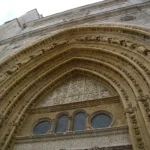Amsterdam, a city woven from canals, cobblestones, and rich artistic heritage, proudly hosts the Van Gogh Museum. This cultural beacon offers not only an intimate glimpse into one of history’s most troubled and brilliant painters but also stands as a testament to architectural finesse and thoughtful preservation. Whether arriving from Schiphol Airport, the bustling Centraal Station, or the lively city center, visitors can find their way to this art sanctuary with ease. As you approach, prepare to walk among canvases where color and emotion converge, enriched by the sculptural elegance of the museum’s design.
Table of Contents
Architectural Elegance Next to a Master’s Legacy
The Van Gogh Museum’s building itself is a study in modern elegance and material craftsmanship. Designed in the late 20th century by Gerrit Rietveld’s studio and later expanded by Kisho Kurokawa, the structure combines clean lines with warm natural light that channels focus onto the paintings within. The light softly caresses surfaces rendered in textured concrete and natural stone, evoking quiet contemplation without overwhelming the artwork. This architectural ensemble reflects the delicate balance in Van Gogh’s own work between vibrant intensity and quiet sensitivity.
Materiality and Design Philosophy
Rietveld’s insistence on clarity in form meets Kurokawa’s organic architectural touches, creating a nuanced harmony in space. The museum’s rectangular facade, punctuated by broad glass panels, invites daylight to animate the interiors while maintaining climate control essential for preserving aging paint. These choices reveal a profound respect for both art conservation and sensory experience, ensuring the museum is a living space, not just a container.
Van Gogh: A Life Painted in Passion and Turmoil
Vincent van Gogh’s story is as compelling as his brushwork. Born in 1853 in the Netherlands, his artistic journey was marked by fierce emotional currents and remarkable evolution. The museum’s collection spans his early somber works to the later exuberant swirls of color in “Starry Night” and “Sunflowers.” This shifting style mirrors his own personal struggles and passions, transforming pain into beauty that resonates centuries later.
The Importance of the Museum’s Collection
Housing more than 200 paintings, 500 drawings, and 700 letters, the Van Gogh Museum preserves an extraordinary archive that not only displays art but reveals the painter’s intimate thoughts and influences. This juxtaposition of artwork with personal correspondence affords visitors a rare insight into his process, inspirations, and resilience. The collection, assembled chiefly by Van Gogh’s brother Theo and later by dedicated collectors, remains one of the most comprehensive in the world.
Getting There: Convenient Routes Across Amsterdam
The museum lies in the bustling Museumplein district, surrounded by green spaces and cultural landmarks such as the Rijksmuseum. For travelers arriving at Amsterdam Centraal Station, trams 2 or 12 wind through the city to the Van Gogh Museum stop in about 15 minutes. From Schiphol Airport, direct trains to Amsterdam Zuid and a short tram ride offer another seamless option. Cycling enthusiasts can enjoy Amsterdam’s famous bike paths, parking readily available near the museum.
- From Centraal Station: Tram 2 or 12 (about 15 minutes).
- From Schiphol Airport: Train to Amsterdam Zuid + tram 5.
- Bike rental options are abundant in city center.
- Accessibility: The museum accommodates visitors with mobility needs.
Maximizing Your Visit: Timing, Tours, and Reservations
To fully appreciate the museum’s gallery rooms and special exhibitions, timing your visit wisely is essential. Weekdays, particularly Tuesday through Thursday mornings, offer a less crowded atmosphere, allowing closer study of delicate brush strokes and subtle color gradients. Weekends can swell with tourists, inviting a more bustling ambiance.
For those drawn to Amsterdam’s rich cultural scene, the nearby Rijksmuseum offers an elegant journey through Dutch art and history that complements a Van Gogh visit.
Booking Ahead for Seamless Entry
Tickets should be purchased online in advance to avoid long queues, especially in peak seasons around spring and summer. Options include guided tours, which enhance understanding of Van Gogh’s techniques and artistic evolution, and audio guides available in multiple languages. Group visits and educational programs provide deeper engagement for enthusiasts eager to explore art beyond surface appreciation.
Local Flavors and Nearby Stays
The Museumplein vicinity boasts a variety of charming guesthouses and boutique accommodations that blend modern comfort with Amsterdam’s historic soul. After absorbing hues and textures of Van Gogh’s work, culinary explorers may enjoy traditional Dutch fare nearby. Try apple pie at a cozy café or sample Dutch cheeses at a market stall, grounding your cultural immersion with local tastes and convivial atmospheres.
After visiting the Van Gogh Museum, wandering through Amsterdam’s must-see landmarks and cultural spots enriches your understanding of the city’s unique charm and history.
Surprising Facts You Might Miss
Many are unaware that Van Gogh only sold one painting during his lifetime. His revolutionary impasto technique, where paint thickly builds texture, was initially met with disbelief but now defines his legacy. The museum building also features subtle art in its structure-a tribute to Van Gogh’s palette visible in floor mosaics and wall treatments, a quiet dialogue between painter and space.
Plan Your Visit with Official Resources
For the latest tickets, exhibitions, and visitor information, the Van Gogh Museum maintains an official site, designed for easy navigation and comprehensive updates.
Van Gogh Museum Official Website

- Van Gogh Museum, Kurokawa wing by Sebastian Koppehel on Wikimedia Commons – cc by 4.0
